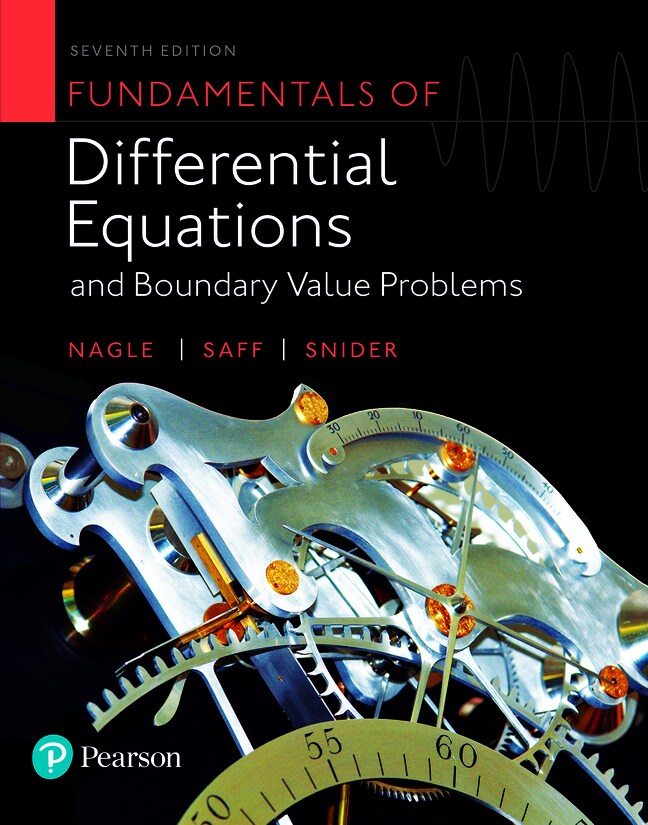
Fundamentals of Differential Equations with Boundary Value Problems, 7th edition
- R Kent Nagle
- , Edward B. Saff
- , Arthur David Snider

- Listen on the go
Learn how you like with full eTextbook audio
- Find it fast
Quickly navigate your eTextbook with search
- Stay organized
Access all your eTextbooks in one place
- Easily continue access
Keep learning with auto-renew
Fundamentals of Differential Equations and Boundary Value Problems by Nagle, Saff and Snider introduces basic theory and applications, exploring modern applications in science and engineering. It can be used with various course approaches (theory, methodology, applications and numerical methods) and used in conjunction with commercially available software. In the 7th Edition, new problems deal with such topics as axon gating variables and oscillations of a helium-filled balloon on a cord. Novel problems accompany the new projects. New examples deal with variation of parameters, Laplace transforms, the Gamma function, and eigenvectors among others. A shorter version, Fundamentals of Differential Equations, 9th Edition, contains enough material for a 1-semester course.
Published by Pearson (January 1st 2021) - Copyright © 2022
ISBN-13: 9780137394524
Subject: Advanced Math
Category: Differential Equations
1. Introduction
- 1.1 Background
- 1.2 Solutions and Initial Value Problems
- 1.3 Direction Fields
- 1.4 The Approximation Method of Euler
2. First-Order Differential Equations
- 2.1 Introduction: Motion of a Falling Body
- 2.2 Separable Equations
- 2.3 Linear Equations
- 2.4 Exact Equations
- 2.5 Special Integrating Factors
- 2.6 Substitutions and Transformations
3. Mathematical Models and Numerical Methods Involving First Order Equations
- 3.1 Mathematical Modeling
- 3.2 Compartmental Analysis
- 3.3 Heating and Cooling of Buildings
- 3.4 Newtonian Mechanics
- 3.5 Electrical Circuits
- 3.6 Improved Euler's Method
- 3.7 Higher-Order Numerical Methods: Taylor and Runge-Kutta
4. Linear Second-Order Equations
- 4.1 Introduction: The Mass-Spring Oscillator
- 4.2 Homogeneous Linear Equations: The General Solution
- 4.3 Auxiliary Equations with Complex Roots
- 4.4 Nonhomogeneous Equations: The Method of Undetermined Coefficients
- 4.5 The Superposition Principle and Undetermined Coefficients Revisited
- 4.6 Variation of Parameters
- 4.7 Variable-Coefficient Equations
- 4.8 Qualitative Considerations for Variable-Coefficient and Nonlinear Equations
- 4.9 A Closer Look at Free Mechanical Vibrations
- 4.10 A Closer Look at Forced Mechanical Vibrations
5. Introduction to Systems and Phase Plane Analysis
- 5.1 Interconnected Fluid Tanks
- 5.2 Elimination Method for Systems with Constant Coefficients
- 5.3 Solving Systems and Higher-Order Equations Numerically
- 5.4 Introduction to the Phase Plane
- 5.5 Applications to Biomathematics: Epidemic and Tumor Growth Models
- 5.6 Coupled Mass-Spring Systems
- 5.7 Electrical Systems
- 5.8 Dynamical Systems, Poincaré Maps, and Chaos
6. Theory of Higher-Order Linear Differential Equations
- 6.1 Basic Theory of Linear Differential Equations
- 6.2 Homogeneous Linear Equations with Constant Coefficients
- 6.3 Undetermined Coefficients and the Annihilator Method
- 6.4 Method of Variation of Parameters
7. Laplace Transforms
- 7.1 Introduction: A Mixing Problem
- 7.2 Definition of the Laplace Transform
- 7.3 Properties of the Laplace Transform
- 7.4 Inverse Laplace Transform
- 7.5 Solving Initial Value Problems
- 7.6 Transforms of Discontinuous Functions
- 7.7 Transforms of Periodic and Power Functions
- 7.8 Convolution
- 7.9 Impulses and the Dirac Delta Function
- 7.10 Solving Linear Systems with Laplace Transforms
8. Series Solutions of Differential Equations
- 8.1 Introduction: The Taylor Polynomial Approximation
- 8.2 Power Series and Analytic Functions
- 8.3 Power Series Solutions to Linear Differential Equations
- 8.4 Equations with Analytic Coefficients
- 8.5 Cauchy-Euler (Equidimensional) Equations
- 8.6 Method of Frobenius
- 8.7 Finding a Second Linearly Independent Solution
- 8.8 Special Functions
9. Matrix Methods for Linear Systems
- 9.1 Introduction
- 9.2 Review 1: Linear Algebraic Equations
- 9.3 Review 2: Matrices and Vectors
- 9.4 Linear Systems in Normal Form
- 9.5 Homogeneous Linear Systems with Constant Coefficients
- 9.6 Complex Eigenvalues
- 9.7 Nonhomogeneous Linear Systems
- 9.8 The Matrix Exponential Function
10. Partial Differential Equations
- 10.1 Introduction: A Model for Heat Flow
- 10.2 Method of Separation of Variables
- 10.3 Fourier Series
- 10.4 Fourier Cosine and Sine Series
- 10.5 The Heat Equation
- 10.6 The Wave Equation
- 10.7 Laplace's Equation
11. Eigenvalue Problems and Sturm-Liouville Equations
- 11.1 Introduction: Heat Flow in a Non-uniform Wire
- 11.2 Eigenvalues and Eigenfunctions
- 11.3 Regular Sturm-Liouville Boundary Value Problems
- 11.4 Nonhomogeneous Boundary Value Problems and the Fredholm Alternative
- 11.5 Solution by Eigenfunction Expansion
- 11.6 Green's Functions
- 11.7 Singular Sturm-Liouville Boundary Value Problems.
- 11.8 Oscillation and Comparison Theory
12. Stability of Autonomous Systems
- 12.1 Introduction: Competing Species
- 12.2 Linear Systems in the Plane
- 12.3 Almost Linear Systems
- 12.4 Energy Methods
- 12.5 Lyapunov's Direct Method
- 12.6 Limit Cycles and Periodic Solutions
- 12.7 Stability of Higher-Dimensional Systems
13. Existence and Uniqueness Theory
- 13.1 Introduction: Successive Approximations
- 13.2 Picard's Existence and Uniqueness Theorem
- 13.3 Existence of Solutions of Linear Equations
- 13.4 Continuous Dependence of Solutions
Appendices
- Review of Integration Techniques
- Newton’s Method
- Simpson’s Rule
- Cramer’s Rule
- Method of Least Squares
- Runge-Kutta Procedure for n Equations
- Software for Analyzing Differential Equations